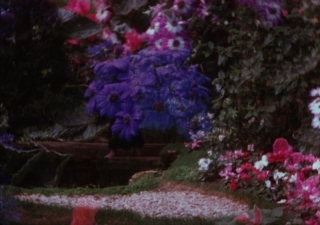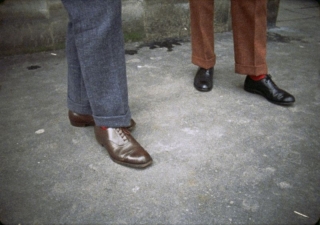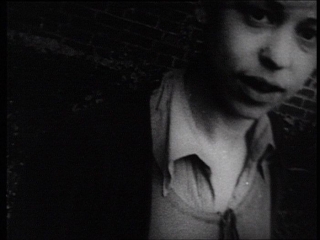Date: 23 April 2015 | Season: Gregory Markopoulos: Film as Film | Tags: Gregory Markopoulos
FILM AS FILM: THEORY AND PRACTICE IN THE WORK OF GREGORY J. MARKOPOULOS
Thursday 23 April 2015, at 6pm
Stadtkino Basel
Introduction by Maja Naef and Markus Klammer
The Greek-American filmmaker Gregory J. Markopoulos (1928–1992) was one of the key figures in the development of postwar avant-garde film, and a co-founder of the New American Cinema Group. In his exquisitely stylized and dreamlike early films, and in the stunning works of the sixties and seventies, Markopoulos formulated a maverick aesthetic characterized by incomparable formal rigor, fascinating beauty, and the penetrating representation of interior worlds that emerge from the entwinement of image and sound into an ecstatic filmic language. He was able to infuse his films with poetic density and force using minimal filmic and financial means. Although the archive of his films, texts, research materials, correspondence and library has been located in Switzerland since his death, Markopoulos’ films have yet to be officially shown here, nor have they been the subject of extended scholarly discussion. On the occasion of the publication of his collected writings in September 2014, texts which underpin Markopoulos’ oeuvre with far-reaching theoretical reflections, this event presents three film programs and a colloquium that will discuss the many different aspects of his work.
Jonas Mekas, Gregory J. Markopoulos Shoots Backgrounds for Galaxie (excerpt of Walden), c.1966, c.2 min
Mark Webber presents the book Film as Film: The Collected Writings of Gregory J. Markopoulos (The Visible Press, 2014).
A collaboration between Stadtkino Basel, eikones NCCR Iconic Criticism, and the Department of Media Studies at the University of Basel.
Date: 23 May 2015 | Season: Gregory Markopoulos: Film as Film | Tags: Gregory Markopoulos
THE ILLIAC PASSION
Saturday 23 May 2015, at 8:15pm
Zurich Videoex Festival
Throughout his life, Markopoulos remained closely connected to his heritage and made many works that connected with ancient Greek culture. The Illiac Passion, one of his most highly acclaimed films, is a visionary interpretation of ‘Prometheus Bound’ starring mythical beings from the 1960s underground. The cast includes Jack Smith, Taylor Mead, Beverly Grant, Gregory Battcock and Gerard Malanga, and Andy Warhol appears as Poseidon riding an exercise bike. The extraordinary soundtrack of this re-imagining of the classical realm features a fractured reading (by the filmmaker) of Henry Thoreau’s translation of the Aeschylus text and excerpts from Bartók’s Cantata Profana. Writing about this erotic odyssey, Markopoulos asserted that, “the players become but the molecules of the nude protagonist, gyrating and struggling, all in love, bound and unbound, from situation to situation in the vast sea of emotion.”
Gregory J. Markopoulos, The Illiac Passion, 1964-67, USA, 16mm, colour, sound, 91 min
PROGRAMME NOTES
THE ILLIAC PASSION
Saturday 23 May 2015
Zurich Videoex Festival
THE ILLIAC PASSION
Gregory J. Markopoulos, USA, 1964-67, 16mm, sound, colour, 91 minutes
“Metamorphosis of the filmmaker. Passions of the filmmaker. Out of his breast the free flowing blood of the creation of a motion picture which depicts the passions of mankind and of everyman in general. The filmmaker selecting and offering to his actors the inheritance of themselves, transforming them through themselves, their own life’s scenario, onto the motion picture screen. A screen in which everything is both transfixed and changed. Not only the filmmaker undergoes changes, i.e. the creative endeavor, but his actors or non-actors, and everyone who associates himself with the very moments during which the filmmaker is working. In this case the greatest alteration taking place towards the film spectator. The new film spectator of the new cinema. […]
“Set afire, the soul of the film spectator and the mythic characters or real personalities of The Illiac Passion commence to alternate, sometimes obliterate and then return to a moment passed or forgotten. That moment taking on greater meaning (upon its return, second return or reference in the film – via single frames, clusters of frames, and the classic principles of film editing), the symbols, the individual psychology united in a single structure, i.e. The Illiac Passion. All revealing the same story, but in variation, all united, all invoking the passions, and all seen through the vibrant passion of the hero, Mr Richard Beauvais as the apotheosis of a Prometheus who is not to bound to a rock, but bound to his own passions; i.e. his own life’s scenario. And, all the various myths which the filmmaker uses in this development in The Illiac Passion become involved in that time development known as eternity.”
(Gregory J. Markopoulos, The Illiac Passion, 1967)
Back to top
Date: 24 May 2015 | Season: Gregory Markopoulos: Film as Film | Tags: Gregory Markopoulos
GREGORY J. MARKOPOULOS: EARLY FILMS OF THE 40s & 50s
Sunday 24 May 2015, at 6:30pm
Zurich Videoex Festival
Having made 8mm films as a child, Markopoulos sought to advance his knowledge of filmmaking by enrolling at the USC Film School, where he attended lectures by Joseph von Sternberg and observed productions of Fritz Lang, Alfred Hitchcock and Alexander Korda. His first 16mm film, Psyche, was made in Los Angeles at this time, concurrent with the first films by Curtis Harrington and Kenneth Anger. Abandoning his studies after only three semesters, he returned to his hometown of Toledo, Ohio, and completed some half dozen films. These early works often explore themes of sexual awakening and the anxiety of coming to terms with homosexuality in an age of repression. In the mid-1950s, the filmmaker embarked on the ill-fated feature Serenity in Greece before re-emerging with Twice a Man (1963), the work that secured Markopoulos’ position as one of independent cinema’s leading figures.
Gregory J. Markopoulos, Psyche, 1947, 24 min
Gregory J. Markopoulos, Christmas-USA-1949, 1950, 13 min
Gregory J. Markopoulos, Eldora, 1953, 11 min
Gregory J. Markopoulos & Robert C. Freeman, Swain, 1950, 20 min
PROGRAMME NOTES
GREGORY J. MARKOPOULOS: EARLY FILMS OF THE 40s & 50s
Sunday 24 May 2015
Zurich Videoex Festival
PSYCHE
Gregory J. Markopoulos, 1947, USA, 16mm, color, sound, 24 min
Psyche, which takes as its source an unfinished novella of the same name by Pierre Louÿs, is a remarkably ambitious and sensual work for a 19-year old to have made in the late 1940s – addressing themes of eros and lesbianism, and containing sequences of montage that presage the techniques of rapid editing that advance in later works. Psyche can stand alone, but was also shown together with Lysis and Charmides (both made in Toledo the following year, inspired by Platonic dialogues) in the trilogy Du sang de la volupte et de la mort (1947-48).
“The first thing which I did was to delete the novelette of its lush rhetoric and retain only its symbolic color. In Psyche, color plays an important role, similar to the role which color plays in the paintings of Toulouse Lautrec. Color reflects the true character of the individual before us, whether it be on the screen, in a painting, or in the street. Color is Eros.” (Gregory J. Markopoulos, Psyche’s Search for the Herb of Invulnerability, 1955)
CHRISTMAS-USA-1949
Gregory J. Markopoulos, 1950, USA, 16mm, b/w, sound, 13 min
Having abandoned his studies at USC, Markopoulos returned to Ohio and completed some half dozen films before shooting the feature film Serenity in Greece. Christmas-USA-1949 (aka Christmas USA) weaves together documentary and fiction to convey a moment of awakening, and was shot at the ‘Cavalcade of Amusements’ travelling fairground, and in the Markopoulos family home and local surrounds.” Its closing credits declare “the end of a period.”
ELDORA
Gregory J. Markopoulos, 1953, USA, 16mm, color, silent, 11 min
“The dreamlike Eldora describes love’s fragmenting effects on the consciousness of an adolescent girl.” (Kristin M. Jones). Eldora was shot on 8mm stock given to the filmmaker by the LA-based exhibitor and collector Raymond Rohauer, and is dedicated to Robert C. Freeman, his collaborator on Swain. In his writings, Markopoulos refers to the film’s “cautious and excruciatingly slow movement” and describes its heroine “proceeding as if with lunar strides across the wet, soft, earthly shore matter of the Maumee River.”
SWAIN
Gregory J. Markopoulos & Robert C. Freeman, 1950, USA, 16mm, color, sound, 20 min
“An exquisite early psychodramatic trance film reminiscent of Maya Deren’s films, Swain is loosely inspired by Nathaniel Hawthorne’s Fanshawe and is rich in metaphor. Starring Markopoulos, Swain is an evocation in gentle images and visual symbols of a subconscious rejection of the stereotyped masculine role that both society and women insist upon. This rejection takes the form of escape – a flight in fantasy from what is visually perceived as crude, repelling sexuality into the purity of creative activity, of nature, and of the individual personality left inviolate.” (Donald Weinstein, Swain: Flowers and Flight, 1963)
Back to top
Date: 25 October 2015 | Season: Gregory Markopoulos: Film as Film | Tags: Gregory Markopoulos
GREGORY J. MARKOPOULOS
Sunday 25 October 2015, at 3:45pm
Lisbon Doclisboa at Culturgest
Figura ímpar na história do cinema, Markopoulos abandonou os Estados Unidos, depois de ter sido uma das figuras cimeiras do New American Cinema, vindo, inclusivamente, a retirar os seus filmes de circulação. Na última década da sua vida, dedicou-se a rever e a reeditar os seus filmes desde finais dos anos 1940, num projecto de 80 horas, Eniaios (palavra grega, significan- do “carácter único” e “unidade”), ciclo que, enquanto tal, e como um ritual, se destina a ser visto cada quatro anos, num sítio único, Temenos.
Gregory J. Markopoulos, Gilbert and George (ENIAIOS III – Reel 1), 1975/1989-91, 12 min
Markopoulos retratou artistas como Moravia, Nureyev ou De Chirico. Este retrato da dupla Gilbert & George é marcado pela ausência da imagem interrompida por fragmentos dos corpos destas duas esculturas vivas, e pela ausência de movimento.
Gregory J. Markopoulos, Genius (ENIAIOS – Reels 2, 3, 4), 1970/1989-91, 80 min
Um retrato triplo, inspirado na lenda de Fausto, do artista britânico David Hockney, do pintor surrealista argentino Leonor Fini e do comerciante de arte Daniel-Henry Kahnweiler. Com uma estrutura calculada, Genius constitui a secção central de Eniaios III.
Projecção precedida da apresentação do livro Film as Film: The Collected Writings of Gregory J. Markopoulos, organizado por Mark Webber, com um prefácio de P. Adams Sitney e publicado por The Visible Press (2014).
Date: 23 January 2017 | Season: Shoot Shoot Shoot 2016 | Tags: Gregory Markopoulos, Shoot Shoot Shoot
SHOOT SHOOT SHOOT: THE LONDON FILM-MAKERS’ CO-OP
Monday 23 January 2017, at 6:30pm
Glasgow CCA
50th anniversary talk and book launch presented by LUX Scotland
In late 1966, a manifesto announcing the formation of the London Film-Makers’ Co-operative was published in the first issue of the organisation’s magazine Cinim:
LONDON FILM-MAKERS COOP ABOUT TO BE LEGALLY ESTABLISHED STOP PURPOSE TO SHOOT SHOOT SHOOT SHOOT SHOOT STOP NEVER STOP NO BREAD NO PLACE TO LAY OUR HEADS NO MATTER JUST MIND IF YOU WANT TO MAKE MONEY STOP IF YOU LIKE BRYAN FORBES STOP IF YOU READ SIGHT AND SOUND STOP IF YOU WANT TO MAKE FILMS I MEAN FILMS COME ALL YOU NEEDS IS EYES IN THE BEGINNING STOP GEN FROM 94 CHARING CROSS ROAD W.C.2 PARTURITION FINISHED SCREAMS BEGIN STOP
This memo was dispatched from the LFMC’s first base at Better Books, a shop on London’s Charing Cross Road, where the organisation evolved from a film society into a distributor of experimental and non-commercial films. The ambition to stimulate the production of new work was there from the beginning, but it was to take a few more years for the Co-op to establish its own film workshop, a unique facility in which its filmmakers fashioned a radically new form of cinema.
In this illustrated talk, Mark Webber will trace the evolution of the LFMC from its emergence in the underground scene to becoming one of the major centres of a worldwide network of avant-garde film culture in the mid-1970s.
Mark Webber is an independent curator of artists’ film and video, and a co-founder of The Visible Press. His previous books as an editor include Two Films by Owen Land (2005), Film as Film: The Collected Writings of Gregory J. Markopoulos (2014) and Peter Gidal. Flare Out: Aesthetics 1966–2016 (2016).
To commemorate the 50th anniversary of its predecessor, LUX have recently published Shoot Shoot Shoot: The First Decade of the London Film-Makers’ Co-operative 1966–76. The book gathers together new and historical texts, interviews, film stills, photographs and archival documents, and will be available this evening at a discounted price.
Malcolm Le Grice, Berlin Horse, 1970, 16mm, colour, sound, 7 min
Peter Gidal, Hall, 1968-69, 16mm, b/w, sound, 8 min
Marilyn Halford, Footsteps, 16mm, 1975, b/w, sound, 7 min
Guy Sherwin, At the Academy, 1974, 16mm, b/w, sound, 5 min
Lis Rhodes, Dresden Dynamo, 1974, 16mm, colour, sound, 5 min
John Smith, Associations, 1975, 16mm, colour, sound, 7 min
PROGRAMME NOTES
SHOOT SHOOT SHOOT: THE LONDON FILM-MAKERS’ CO-OP
Monday 23 January 2017, at 6:30pm
Glasgow CCA
BERLIN HORSE
Malcolm Le Grice, UK, 1970, 16mm, colour, sound, 7 min
“Berlin Horse is an exploration of the film medium. It is also concerned with making certain conceptions about time in a more illusory way than I have been inclined to explore in many other of my films. It attempts to deal with some of the paradoxes of the relationships of the ‘real’ time which exists when the film was being shot, with the ‘real’ time which exists when the film is being screened, and how this can be modulated by technical manipulation of the images and sequences.”
HALL
Peter Gidal, UK, 1968-69, 16mm, b/w, sound, 10 min
“Demystified reaction by the viewer to a demystified situation; a cut in space and an interruption of duration through (obvious) jumpcut editing within a strictly defined space. Manipulation of response and awareness thereof: through repetition and duration of image. Film situation as structured, as recorrective mechanism.” (Notes from 1969) “Still utilizing at that time potent (signifying, overloaded) representations.” (1972)
AT THE ACADEMY
Guy Sherwin, UK, 1974, 16mm, b/w, sound, 5 min
“Makes use of found footage, hand printed on a simple homemade contact printer and processed in the kitchen sink. At the Academy uses displacement of a positive and negative sandwich of the same loop. Since the printer light spills over the optical soundtrack area, the picture and sound undergo identical transformations.”
FOOTSTEPS
Marilyn Halford, UK, 1975, 16mm, b/w, sound, 6 min
“Footsteps is in the manner of a game re-enacted, the game in making was between the camera and actor, the actor and cameraman, and one hundred feet of film. The film became expanded into positive and negative to change balances within it; black for perspective, then black to shadow the screen and make paradoxes with the idea of acting, and the act of seeing the screen. The music sets a mood then turns a space, remembers the positive then silences the flatness of the negative.”
DRESDEN DYNAMO
Lis Rhodes, UK, 1974, 16mm, colour, sound, 4 min
“It was perhaps the question of sound – the uncertainty of any synchronicity between what was seen and what was said that began an investigation into the relationship of sound to image. Dresden Dynamo is a film that I made without a camera – in which the image is the soundtrack, the soundtrack the image. A film document.”
ASSOCIATIONS
John Smith, UK, 1975, 16mm, color, sound, 7 min
“Images from magazines and color supplements accompany a spoken text taken from Word Associations and Linguistic Theory by the American psycholinguist Herbert H Clark. By using the ambiguities inherent in the English language, Associations sets language against itself. Image and word work together/against each other to destroy/create meaning.” (John Smith)
Back to top




